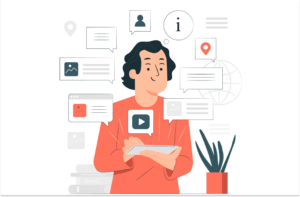Increasing your website’s traffic is always a goal among businesses. More traffic often results in more leads and more revenue. However, it can be difficult to find new ways to drive traffic to your website due to how competitive other companies are. Fortunately, there are a lot of different ways that you can drive traffic to your website. As you probably know, it can be overwhelming to decide which initiative(s) to try. Before we get into the 11 best ways to increase website traffic, let’s go over some website traffic basics.
Why is Website Traffic Important?
Website traffic refers to the number of people visiting your website. An increase in website traffic is important because it often results in an increase in conversions and revenue. However, if you’re not optimizing pages for relevant visitors, then increasing your traffic might not always result in more of either. It might do the opposite, increasing your bounce rate. That is why it’s so important to ensure that you are researching what your customers are interested in. Then, use that information to your advantage when planning out new initiatives.
Organic Traffic vs Paid Traffic
When you are looking to drive traffic to your website, it’s important to make a plan on how you want to execute increasing your website traffic. The biggest decision that you will have to make is if you want to pay for ads, or if you want to optimize your website to organically increase website traffic. There are pros and cons to both organic and paid traffic initiatives. First, let’s get familiar with organic traffic.
Organic Traffic
Organic traffic is also known as SEO or search engine optimization. This refers to optimizing your website to increase your website traffic through unpaid tasks. Increasing your organic traffic is often harder to implement than paid, however, it often works better long-term. It can take a few months to see consistent results from SEO. But, once you’ve implemented tactics, they will continue to work and grow. Often marketers can get impatient waiting for results, but this is normal so don’t get discouraged.
Paid Traffic
On the other hand, we have paid traffic. Paid traffic is often referred to as SEM or search engine marketing. It includes Google Ads and other search engine advertising platforms. Paid traffic can seem more attractive to marketers because the results are immediate and can be easily tracked. While paid traffic is a great option to drive traffic to your website, it can get expensive over a long period of time. Ads also require a lot more upkeep and maintenance over time. Now that you are familiar with the basics, let’s dive into 11 tips that will help you drive traffic to your website.

1. Use Keywords
Using keywords is important for both organic and paid marketing initiatives. This is how you’re going to get relevant website visitors that are interested in what your business has to offer. All of the organic marketing initiatives mentioned below include keywords, which means a lot of keyword research. Luckily, Google has made keyword research easy by providing us with a Google Keyword Planner tool. With Google Keyword Planner, you can find out what the most popular search terms are for your blog posts, landing page content, and even your company’s name. I suggest taking a look at this tool prior to starting any SEO initiatives to ensure you’re headed in the right direction. When you add keywords to your landing pages, try not to include more than 1-3 for every 100 words, because Google will think that you’re “keyword stuffing” to try and rank better.
2. Optimize Your Landing Pages
Similar to keywords, landing pages are an essential part of organic and paid marketing initiatives. If you don’t have strong landing pages, you will miss out on a lot of conversions. As a result, your bounce rate will increase. Once set up, landing pages are easy to maintain and can drive a lot of traffic. Your keyword planning will help you write content for these pages. In addition to increase the relevance of the pages both organically and paid. This means that the pages will show higher on the search results page, which is always the goal.
3. Start a Blog
Blogs are one of the best ways that you can drive traffic to your website organically. This is because your company can write about common topics in your industry, answer commonly asked questions, and more, and rank organically on search engines. So when you check Google rankings on relevant keywords, those blogs rank organically on top of SERPs. To get started, your company can easily set up your blog with a hosting software like WordPress or Wix. The hosting software can help you with the setup process, and both platforms are very simple and easy to use.
Before your blog website goes live, I would suggest writing at least 3 articles so your website isn’t empty. This looks more professional and you’re more likely to get subscribers with more content. Now, the hard part is finding time to come up with blog topics and write the articles. Even if you just get to one article a month, if done right the article can drive traffic to your website. When writing a blog, you can and should mention your company, but only if it’s relevant. Try not to overdo it by trying to sell your company, your articles are a resource for information, not an advertisement. If you need help writing a good blog post, this article can help.
4. Google Ads
Running Google Ads is a great way for your company to appear at the top of the search results page. This means your company will be more likely to be clicked on than your competitors in addition to appearing before any organic results. You can use your keyword research to help you choose keywords that you should bid on for your ads, and align your landing pages with the keywords you bid for. Google Ads can be an affordable form of advertising. The best part of advertising on Google is all of the data that you can analyze to see what kind of ads drive the most clicks and results based on your goals. Take a look at this guide for the 9 best Google Ad tips to drive conversions on your website.
5. Organic Social Media
So many companies overlook organic social media. It’s a simple, easy way to generate website traffic for free. LinkedIn, Facebook, and Twitter are the most popular social media platforms for B2B companies. These three platforms are very different and should be treated as such. This doesn’t necessarily mean that you need to create different content for each channel, just frame your wording a little differently for each. For example, LinkedIn is a very professional platform, so I would limit the emojis and jokes to just a few. On the other hand, on a platform like Facebook, you can be a lot more casual with your content. So, you can share the same blog post, just change the content of the post slightly for each platform.
6. Make a Guest Appearance on a Podcast
Besides being a fun experience, being a guest on a podcast is a great way to get your company’s name out there in front of a wide audience. When you are on the podcast, you will give yourself a brief introduction of who you are, what your business does, and where the listeners can connect with you. Most business podcasts have a website where you can submit an application, or you can reach out to a member of their team via email or LinkedIn with a summary of your experience and topics you’d like to talk about.
When researching podcasts, it’s best to start small. There’s a good chance that your first podcast won’t be Gary Vee’s Audio Experience. If you’re having a hard time finding a few different podcasts to reach out to, check out this list of the 20 best business podcasts to find a few that you resonate with. For more information on how to reach out to a podcast, check out this video here.
7. Video Advertising
If your company is a SaaS, or software as a service company, then video ads are a great option for you. Sometimes it can be difficult to show what your company has to offer with one image or even a carousel ad. You can use video ads in your social media advertising or show before or during a YouTube video. When creating video ads, it’s best to start with a hook that will hopefully prevent the viewer from skipping the ad. In addition, keep the ad short and to the point as most viewers won’t watch the entire video so you won’t want to leave the important information to the end. You will want to include a relevant call to action with a landing page that reflects the content that was in the video.

8. Backlink
Backlinks are an easy way to build website credibility as well as generate website traffic. If you come across a blog that mentions a topic that you have written a blog about, you can reach out to the writer of the post, and ask them to link to your blog. You can offer an in-direct link exchange in return. It has to be an indirect exchange, meaning they link to your website and you link to another site because Google will catch on to the exchange. You also don’t want the same site to link back to yours over and over again, so it’s best to limit the exchange to just once.
9. Update Old Content
If you have a blog, then it’s crucial to update your old posts every year. If one of your blogs is titled “The Best B2B Lead Generation Tactics for 2019”, it’s not going to be clicked on. Even if the content is amazing, readers will think it’s dated and irrelevant information for the current year. At the end of the year, it’s best to set up some time to go through your old articles and update dates as well as the content. Since business and technology are both constantly evolving, it’s important to keep your content up-to-date in order to increase website traffic. This concept is the same for any other form of content that you have that may be dated, like Google Ads, social media ads, and more.
10. Influencer Marketing
Influencer marketing is not for every business, which is why it’s last on this list. However, for the companies that influencer marketing does align with, it can drive a ton of traffic. The first step is to find a few influencers that you are interested in working with. It’s important to find an influencer who shares a similar target audience as your company as well as similar values and ethics that you want to represent your company. Finding an influencer that you want to represent your company is one of the hardest parts of influencer marketing. You will want to do a lot of in-depth research about their previous partnerships, history, and if they’ve ever been involved in any controversies. It’s a good idea to follow and engage with the influencers so they become familiar with your name.
Once you have found a few potential influencers, you can reach out to them and tell them a bit about yourself and what your company does. Most influencers will include an email to contact them or their manager in their social media bio. Influencer marketing can get pricey, so just be wary of this before you start negotiating with influencers.
11. Quora Marketing
A lot of companies don’t think of Quora when they think of marketing. But, it is a great place to get a lot highly relevant views and engagement on both paid and organic content. Quora is essentially a social media channel where you can ask, answer, or comment back on questions to increase brand awareness. You are able to join relevant groups that your audience would be in. Or, use Quora’s search capabilities to search up your company’s name or your competitor’s name to see if anyone is asking questions about them. When you answer questions, try not to be too promotional, but you’ll want to include links to relevant articles or webpages where people can continue to learn. For paid Quora marketing, you can boost questions, answers, or create display ads.
What’s Next?
Once you see an increase in your website traffic on Google Analytics, what’s next? It can be encouraging to see an increase in your website visitors, but it can be hard to do anything with this number if you’re not seeing an increase in conversions. With Visitor Queue, you can take the power back and reach out to your new visitors. Visitor Queue is a B2B lead generation software that identifies the companies visiting your website. Identify the key employees working at the companies we identify, along with their email addresses, phone numbers, and LinkedIn profiles so you can reach out to them. Find out how the companies got to your website, the pages they viewed, and the time they spent on each page to better frame your pitch. Start your 14-day free trial today and generate 10-20% more revenue.
Wrap Up
This concludes our list of the 11 best ways to drive traffic to your website. I hope you were able to find a few new marketing tactics to try out and increase relevant traffic to your website. If you’re still unsure about what tactic(s) to try, I would suggest picking 2-3 that pique your interest and researching further the pros and cons of those tactics. As always, if you have any questions about how Visitor Queue can help your company identify its anonymous website visitors, do not hesitate to reach out.
 Identify
Identify Personalize
Personalize Benchmark
Benchmark Agencies
Agencies Integrations
Integrations Case Studies
Case Studies Use Cases
Use Cases Blog
Blog Resources
Resources









